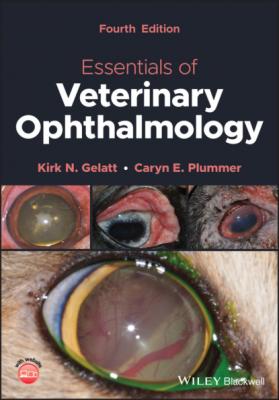Essentials of Veterinary Ophthalmology. Kirk N. Gelatt
Чтение книги онлайн.
Читать онлайн книгу Essentials of Veterinary Ophthalmology - Kirk N. Gelatt страница 24
 of the Canine Optic Nerve (Gillian J. McLellan)
of the Canine Optic Nerve (Gillian J. McLellan)
Chapter 28: Feline Ophthalmology (Mary Belle Glaze, David J. Maggs, and Caryn E. Plummer)
Chapter 29: Equine Ophthalmology (Caryn E. Plummer)
Chapter 30: Food and Fiber Animal Ophthalmology (Bianca C. Martins)
Chapter 31: Avian Ophthalmology (Lucien V. Vallone and Thomas J. Kern)
Chapter 32: Ophthalmology of the New World Camelids (Juliet R. Gionfriddo and Ralph E. Hamor)
Chapter 33: Laboratory Animal Ophthalmology (Seth Eaton)
Chapter 34: Small Mammal Ophthalmology (David L. Williams)
Chapter 35: Exotic Animal Ophthalmology (Thomas J. Kern)
Chapter 36: Neuro‐Ophthalmology (Aubrey A. Webb and Cheryl L. Cullen)
Chapter 37: Ocular Manifestations of Systemic Disease (Aubrey A. Webb and Cheryl L. Cullen)
About the Companion Website
This book is accompanied by a website containing:
www.wiley.com/go/gelatt/essentials4e
Figures from the book as PowerPoint slides
1 Development and Morphology of the Eye and Adnexa
Revised from 6th edition of Veterinary Ophthalmology, Chapter 1: Ocular Embryology and Congenital Malformations, by Cynthia S. Cook; and Chapter 2: Ophthalmic Anatomy, by Jessica M. Meekins, Amy J. Rankin, and Don A. Samuelson
Section I: Development of the Eye and Adnexa
Ocular development has been investigated in some detail in rodents, the dog, and the cow, and demonstrates that the sequence of developmental events is very similar across species. When comparing these studies, one should consider differences in duration of gestation, differences in anatomical end point (e.g., presence of a tapetum, macula, or Schlemm's canal), and when eyelid fusion breaks (during the sixth month of gestation in the human versus two weeks postnatal in the dog and cow) (Tables 1.1 and 1.2).
Gastrulation and Neurulation
Cellular mitosis following fertilization results in transformation of the single‐cell zygote into a cluster of 12–16 cells. With continued cellular proliferation, this morula becomes a blastocyst, containing a fluid‐filled cavity. The cells of the blastocyst will form both the embryo proper and the extraembryonic tissues (i.e., amnion and chorion). At this early stage, the embryo is a bilaminar disc, consisting of hypoblast and epiblast. This embryonic tissue divides the blastocyst space into the amniotic cavity (adjacent to epiblast) and the yolk sac (adjacent to hypoblast).
Gastrulation (formation of the mesodermal germ layer) begins during day 10 of gestation in the dog (day 7 in the mouse; days 15–20 in the human). The primitive streak forms as a longitudinal groove within the epiblast (i.e., future ectoderm). Epiblast cells migrate toward the primitive streak, where they invaginate to form the mesoderm. This forms the three classic germ layers: ectoderm, mesoderm, and endoderm. Gastrulation proceeds in a cranial‐to‐caudal progression; simultaneously, the cranial surface ectoderm proliferates, forming bilateral elevations called the neural folds (i.e., future brain). The columnar surface ectoderm in this area now becomes known as the neural ectoderm.
As the neural folds elevate and approach each other, a specialized population of mesenchymal cells, the neural crest, emigrates from the neural ectoderm at its junction with the surface ectoderm. Migration and differentiation of the neural crest cells are influenced by the hyaluronic acid‐rich extracellular matrix. This acellular matrix is secreted by the surface epithelium as well as by the crest cells, and it forms a space through which the crest cells migrate. The neural crest cells migrate peripherally beneath the surface ectoderm to spread throughout the embryo, populating the region around the optic vesicle and ultimately giving rise to nearly all the connective tissue structures of the eye (Table 1.3).
Table 1.1 Sequence of ocular development in human, mouse, and dog.
| Human (approximate post‐fertilization age) | Mouse (day post‐fertilization) | Dog (day post‐fertilization or P = postnatal day) | Developmental events | ||
|---|---|---|---|---|---|
| Month | Week | Day | |||
| 1 | 3 | 22 | 8 | 13 | Optic sulci present in forebrain |
| 4 | 24 | 9 | 15 | Optic sulci convert into optic vesicles | |
| 10 | 17 | Optic vesicle contacts surface epithelium Lens placode begins to thicken | |||
| 26 | Optic vesicle surrounded by neural crest mesenchyme | ||||
| 2 | 5 | 28 | 10.5 | Optic vesicle begins to invaginate, forming optic cup Lens pit forms as lens placode invaginates Retinal primordium thickens, marginal zone present | |
| 32 | 11 | 19 | Optic vesicle invaginated to form optic cup Optic fissure delineated Retinal primordium consists of external limiting membrane, proliferative zone, primitive zone, marginal zone, and internal limiting membrane Oculomotor nerve present | ||
| 33 | 11.5 | 25 |
Pigment in outer layer of optic cup Hyaloid artery enters through the optic cup Lens vesicle separated from surface ectoderm Retina: inner marginal and outer nuclear zones
|